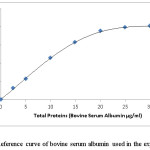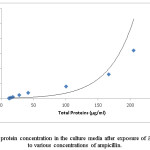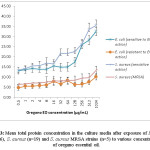Introduction
Overuse and abuse of antibiotics resulted in antibiotic resistance of many pathogens during the last decays1-3. As a result, to this growing resistance, many antibiotic agents has lost their efficacy with dramatic consequences in the treatment of infectious diseases. In the research for new alternative agents, phytochemicals and particularly essential oils (EOs) coming from aromatic and medicinal plants has drawn the scientific attention.4-6 The majority of these compounds are natural defense mechanisms of plants against bacteria, other competitors, or herbivores.7 They are complex mixtures of volatile and aromatic compounds classified primarily as terpenoids and according to the number of isoprene units as monoterpenes and sesquiterpenes.7 More than 3000 EOs has been identified and despite their use in traditional medicine, a very small fraction of about 10% is approved for use in pharmaceuticals, cosmetics and food products. These natural compounds are generally recognized as safe by FDA. Biological activities attributed to EOs are antimicrobial, antiviral, antimycotic, antiparasitic, insecticidal, antidiabetic, antioxidant, and anticancer.8-9 Previous reports have shown that EOs effectiveness is based among others on their ability to disrupt both the cell wall and the cytoplasmic membrane of bacteria, resulting to leakage of intracellular compounds such as proteins.6,10-11 The aim of this work was to study this hypothesis by using oregano EO against clinically isolated strains of Staphylococcus aureus and Escherichia coli.
Materials and Methods
Bacterial strains
The microorganisms utilized in the study composed of 26 E. coli strains and 24 S. aureus strains, were collected and identified in the microbiological departments of various hospitals. All strains were initially stored at -30οC in cryovials then transferred to the laboratory and subcultured in Mueller-Hinton agar (37οC/24h) before testing. Eight out of the 24 strains of S. aureus were identified as methicillin resistant (MRSA).
Essential oils
Cultivated oregano was harvested in mid-summer. Drying was accomplished in a laboratory oven at 30 οC for 48h. Batches of 200 g from dried plant material (stems and leaves) were used for EOs extraction by hydrodistillation in a Clevenger apparatus.4 After collection the EOs dehydrated with sodium sulfate and stored in amber glass vials at -30οC until used.
Antimicrobial action
The microdilution broth method was used for the determination of Minimum Inhibitory Concentration (MIC) of EOs.4-5 In brief, bacterial suspensions equivalent to the 0.5 McFarland index were added in Muller-Hinton broth supplemented with 3% DMSO and increased concentrations of EOs (0.5-1024 μg/mL) in 96-well sterile microplates. Microplates were incubated at 37οC for 24 h and MIC determined only by visual inspection in order to prevent the integrity of the culture. Minimum Bactericidal Concentration (MBC) was determined after MIC by plating 10 μL from each well equal and above the MIC on Muller-Hinton Agar plates. The absence of growth after incubation at 37οC for 24 h, was considered as the Minimum Bactericidal Concentration value.
Assessment of cell wall and cytoplasmic membrane disruption
The Bradford method of protein assay (Pierce® Coomassie Protein Assay Kit, Thermo Scientific™) was used to detect any possible increase of the total proteins into the broth as a result of bacterial cell wall and cytoplasmic disruption occurred by the action of EOs. Therefore, a reference curve was constructed by using elevated concentrations of Total Bovine Serum Albumin (BSA) standards in MH broth and measured photometrically at 595nm (Fig 1). Negative controls (without EOs) and positive controls (with ampicillin) were also used (Fig 2). Ampicillin belongs to the b-lactam group of antibiotics which is known for their bacteriolytic mode of action against Gram (-) and Gram (+) bacteria.12
Results
Inhibitory and bactericidal concentration
In Table 1 the values of MIC and MBC obtained from oregano essential oil against E. coli and S. aureus are shown. All strains of both bacteria were inhibited by the oregano EO. Mean MIC value for Ε. coli was 256 μg/mL (128-1024 μg/mL) and mean MIC value for S. aureus was 128 μg/mL (64-512) indicating a stronger inhibiting action. Regarding the bactericidal effect, oregano EO was most effective against S. aureus with a mean MBC of 64 μg/mL, and 128 μg/mL, respectively, for E. coli.
Table 1: MIC and MBC of oregano Essential oil against clinical strains of E. coli (n=26) and S. aureus (n=24).
| Strain | MIC (μg/mL) | MBC (μg/mL) | ||||
| min | mean | max | min | mean | max | |
| E. coli | 128 | 256 | 1024 | 128 | 128 | 1024 |
| S. aureus | 64 | 128 | 512 | 32 | 64 | 512 |
Effect on bacterial membrane integrity
Figure 1 shows the reference curve of bovine serum albumin initial measurements. The reference curve could be adequately described by the below 4th degree polynomial equation.
 |
Figure 1: Reference curve of bovine serum albumin used in the experiment Click here to View figure |
 |
Figure 2: Total protein concentration in the culture media after exposure of E. coli strains to various concentrations of ampicillin Click here to View figure |
 |
Figure 3: Mean total protein concentration in the culture media after exposure of E. coli (n=26), S. aureus (n=19) and S. aureus MRSA strains (n=5) to various concentrations of oregano essential oil Click here to View figure |
OD = 7E-08[C]4-1E-05[C]3+7E-05[C]2+0.0116[C]+0.4874, where:
OD is the optical density of the photometer and C the concentration of the total proteins in the medium. R2 value was 0.9997 which indicate a fully satisfactory fit. Figure 2 shows the curve obtained by using ampicillin as a positive control. Based on the protein assay over 80% of S. aureus strains (19 out of 24) and 65% of E. coli strains (17 out of 26) exhibited a clear dose-response curve indicating that the target of action of the oregano EO was the disruption of the cell wall and cytoplasmic membrane. However, 5 out of 8 MRSA strains showed no indications of extracellular protein increase after exposure to the EO action (Fig 3).
Discussion
Essential oils as well as their major components are having a variety of targets on the bacterial cell where exhibiting their action. Various reports indicate that EOs can act by degrading the cell wall13 or can damage the cytoplasmic membrane, causing cytoplasm coagulation.14 Their detrimental effect on membrane proteins increase membrane permeability and ends up to leakage of the cell contents.15 The reduction of both the proton motive force and the intracellular ATP content have also reported.16 However the various reports, information on the specific type of action of various EOs is limited and the particular mechanisms involved are still not completely clarified.17 In this study, the mode of action of oregano EO is investigated by using a simple approach which is the estimation of the total proteins in the culture media before and after the addition of increasing concentrations of EO. If the protein content of the micro plate cells contained the exposed to EOs bacteria increases more than in those cells contained the unexposed bacteria then it can be concluded that these proteins were the result of membrane disruption. It is also known that EOs or other components of the experimental mixture – besides the culturing media, does not contain any proteins7-8,20 in order to consider any interferences or bias during the analysis.
The inhibition study showed that the EO of oregano tested was effective at various concentrations against E. coli and S. aureus. It was observed that the MIC and also the MBC values obtained are in accordance with most of other reports which found MIC values between 200-300 μg/m,18-20 although lower values (31-40 μg/mL) are also reported as by Sahin et.al.,21 and Penalver et al.,22 In the present study, Gram-negative bacteria were more resistant than the Gram-negative ones to the EO. This behavior is also observed in previous reports and it is attributed to the more complex cell-wall of Gram-negative bacteria. According to Burt & Reinders23 the Gram-negative cell-wall is impermeable to hydrophobic molecules as is the Gram-positive bacteria and in that manner the EOs are less able to easily affect the cell growth of the Gram-negative bacteria. However, MRSA strains in our study were proven resistant to the EO when compared with their non-MRSA counterparts (Fig 3). This could be the result of an analogous mechanism by which methicillin-resistant Staphylococcus aureus changed the proteins to which β-lactam antibiotics binds and therefore decreasing their effectiveness at disrupting cell wall synthesis.24 The most active compound of oregano essential oil is carvacrol, a natural phenol which can increase the permeability of cytoplasmic membrane.25 As demonstrated by previous reports, carvacrol causes a structural and functional damage on microbial cells targeting on their membranes which results in an increased permeability. Studies on carvacrol’s effectiveness on membrane permeability have confirmed such an action by monitoring either the efflux of H+, K+ and carboxyfluorescein or the ATP pool and the influx of nucleic acid.26-27 In their experiments Gill and Holley (2006)13 showed the release of ATP from carvacrol exposed E. coli strains and considered these results as an indication of non-specific permeabilization of the cytoplasmic membrane while other effects can be anticipated as a result of secondary membrane interactions. However, the mode EOs action depends mostly on their chemical composition (i.e chemotype), and their activity against bacteria is not attributed on a single mechanism but is the result of numerous reactions concerning the bacterial cell.25 Based on this observation it is apparent the various sensitivity levels exhibited by our pathogens.
In conclusion, oregano EO is effective against clinical pathogens as E. coli and S. aureus with a mode of action targeting the bacterial membrane permeability or integrity. However, bacteria resistant to chemical antibiotics seem to be capable of overcoming the action of EOs which requires further investigation before the
EOs or their components could be utilized either in medicine or in food safety.
Acknowledgements
This research was supported by the Master’s Program of the Department of Agricultural Development, Democritus University of Thrace, Greece.
References
- Llor C, Lars B. Antimicrobial resistance: risk associated with antibiotic overuse and initiatives to reduce the problem. Therapeutic advances in drug safety 5(6):229-241 (2014).
CrossRef - Laxminarayan R, Duse A, Wattal C, Zaidi A K, Wertheim H F, Sumpradit N, … & Greko C. Antibiotic resistance—the need for global solutions. The Lancet infectious diseases 13:1057-1098 (2013).
CrossRef - Bezirtzoglou E, Alexopoulos A, Voidarou C. Apparent antibiotic misuse in environmental ecosystems and food. Microbial Ecology in Health and Disease 20:197-198 (2008).
CrossRef - Fournomiti M, Kimbaris A, Mantzourani I, Plessas S, Theodoridou I, Papaemmanouil V, Kapsiotis I, Panopoulou M, Stavropoulou E, Bezirtzoglou E, Alexopoulos A. Antimicrobial activity of essential oils of cultivated oregano (Origanum vulgare), sage (Salvia officinalis), and thyme (Thymus vulgaris) against clinical isolates of Escherichia coli, Klebsiella oxytoca, and Klebsiella pneumoniae. Microbial Ecology in Health and Disease 26:1-7 (2015).
CrossRef - Alexopoulos A, Kimbaris A, Plessas S, Mantzourani I, Theodoridou I, Stavropoulou E, Polissiou MG, Bezirtzoglou E. Antibacterial activities of essential oils from eight Greek aromatic plants against clinical isolates of Staphylococcus aureus. Anaerobe 17:399-402 (2011).
CrossRef - Nazzaro F, Fratianni F, De Martino L, Coppola R, De Feo V. Effect of essential oils on pathogenic bacteria. Pharmaceuticals 6:1451-1474 (2013).
CrossRef - Guenther E. The Essential Oils-Vol 1: History-Origin In Plants-Production-Analysis. Read Books Ltd, (2013).
- Bakkali F, Averbeck S, Averbeck D, Idaomar M. Biological effects of essential oils–a review. Food and Chemical Toxicology 46:446-475 (2008).
CrossRef - Reichling J, Schnitzler P, Suschke U, Saller R. Essential oils of aromatic plants with antibacterial, antifungal, antiviral, and cytotoxic properties–an overview. Forschende Komplementärmedizin/Research in Complementary Medicine 16:79-90 (2009).
- Xu J, Zhou F, Ji BP, Pei RS, Xu N. The antibacterial mechanism of carvacrol and thymol against Escherichia coli. Letters in Applied Microbiology; 47:174-179 (2008).
CrossRef - Oyedemi SO, Okoh AI, Mabinya LV, Pirochenva G, Afolayan AJ. The proposed mechanism of bactericidal action of eugenol,∝-terpineol and g-terpinene against Listeria monocytogenes, Streptococcus pyogenes, Proteus vulgaris and Escherichia coli. African Journal of Biotechnology 8:1280-1286 (2009).
- Kohanski MA, Dwyer DJ, Collins JJ. How antibiotics kill bacteria: from targets to networks. Nature Reviews Microbiology 8:423-435 (2010).
CrossRef - Gill AO, Holley RA. Disruption of Escherichia coli, Listeria monocytogenes and Lactobacillus sakei cellular membranes by plant oil aromatics. International Journal of Food Microbiology 108:1-9 (2006).
CrossRef - Ultee A, Bennik MH, Moezelaar R. The phenolic hydroxyl group of carvacrol is essential for action against the food-borne pathogen Bacillus cereus. Applied and Environmental Microbiology 68 :1561-1568 (2002).
CrossRef - Lambert RJW, Skandamis PN, Coote PJ, Nychas GJE. A study of the minimum inhibitory concentration and mode of action of oregano essential oil, thymol and carvacrol. Journal of Applied Microbiology 91:453-462 (2001).
CrossRef - Ultee A, Smid EJ. Influence of carvacrol on growth and toxin production by Bacillus cereus. International Journal of Food Microbiology 64:373-378 (2001).
CrossRef - Lopez-Romero JC, González-Ríos H, Borges A, Simões M. Antibacterial effects and mode of action of selected essential oils components against Escherichia coli and Staphylococcus aureus. Evidence-Based Complementary and Alternative Medicine;http://dx.doi.org/10.1155/2015/795435 (2015).
CrossRef - De Martino L, De Feo V, Formisano C, Mignola E, Senatore F. Chemical Composition and Antimicrobial Activity of the Essential Oils from Three Chemotypes of Origanum vulgare ssp. hirtum (Link) Ietswaart Growing Wild in Campania (Southern Italy). Molecules 14:2735-2746 (2009).
CrossRef - Ozkalp B, Sevgi F, Ozcan M, Ozcan MM. The antibacterial activity of essential oil of oregano (Origanum vulgare L.). Journal of Food Agricultural and Environment 8:272-274 (2010).
- Castilho PC, Savluchinske-Feio S, Weinhold TS, Gouveia SC. Evaluation of the antimicrobial and antioxidant activities of essential oils, extracts and their main components from oregano from Madeira Island, Portugal. Food Control 23:552-558 (2012).
CrossRef - Şahin F, Güllüce M, Daferera D, Sökmen A, Sökmen M, Polissiou M, Agar G, Özer H. Biological activities of the essential oils and methanol extract of Origanum vulgare ssp. vulgare in the Eastern Anatolia region of Turkey. Food Control 15:549-557 (2004).
CrossRef - Penalver P, Huerta B, Borge C, Astorga R, Romero R, Perea A. Antimicrobial activity of five essential oils against origin strains of the Enterobacteriaceae family. Apmis 113:1-6 (2005).
CrossRef - Burt SA, van der Zee R, Koets AP, de Graaff AM, van Knapen F, Gaastra W, Haagsman HP, Veldhuizen EJA. Carvacrol induces heat shock protein and inhibits synthesis of flagellin in Escherichia coli O157:H7. Applied and Environmental Microbiology 73:4484-4490 (2007).
CrossRef - Vaara M, Agents that increase the permeability of the outer membrane. Microbiological Reviews 56:395-411 (1992).
- Di Pasqua R, Betts G, Hoskins N, Edwards M, Ercolini D, Mauriello G, Membrane toxicity of antimicrobial compounds from essential oils. Journal of Agricultural and Food Chemistry 55:4863-4870 (2007).
CrossRef - Cristani M, D’Arrigo M, Mandalari G, Castelli F, Sarpietro MG, Micieli D, Venuti V, Bisignano G, Saija A, Trombetta D, Interaction of four monoterpenes contained in essential oils with model membranes:implications for their antibacterialactivity. Journal of Agricultural and Food Chemistry 55:4863-4870 (2000).
- Xu J, Zhou F, Ji BP, Pei RS, Xu N. The antibacterial mechanism of carvacrol and thymol against Escherichia coli. Letters in Applied Microbiology 47:174-179 (2008).
CrossRef

This work is licensed under a Creative Commons Attribution 4.0 International License.




